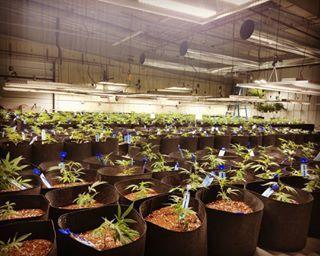
A roomful of people packed the Fairbanks City Council meeting room Monday for the last public hearing on a proposed ordinance that would place limits on marijuana businesses before the council considers approval next month. Most supported the ordinance and called for greater regulation of the industry. Opponents say the measure is unfair and heavy-handed, and would further unfairly treat marijuana and alcohol differently.
Both supporters and opponents of the proposed ordinance told council members they should regulate marijuana like alcohol. That’s what marijuana advocates asked for in their successful 2015 ballot measure that legalized commercial pot growing and sales. And anti-marijuana activist Vivian Stiver emphasized the point by leading others in reciting it at the end of her testimony.
“We have one request – we would like you to regulate marijuana like alcohol,” Stiver said, along with some in the audience.
Stiver cited for example Alcohol and Marijuana Control Office guidelines that call for one type of liquor license to be issued for every 3,000 or so residents. Based on that formula, she says Fairbanks should only have nine retail marijuana shops.
“It’s nine,” Stiver said. “Your ordinance calls for 12. Based on population, it’s nine. That’s how that formula (works).”
But City Clerk Danyielle Snider told the council in January that Fairbanks had 41 liquor dispensaries, mostly bars, and 15 package stores. By way of comparison, the city now has six marijuana retail shops and five growing facilities.
Retailer Dan Peters also asked for equal treatment over the issue of on-site consumption, which the ordinance would prohibit. Peters says marijuana users should be allowed to consume it on-site, at either the point of sale or separate facilities, such as a smoking room.
“I feel like it’s a freedom issue,” Peters said. “If you’re willing to allow alcohol consumption on-site, I believe that it’s reasonable for people who want to consume cannabis.”
But the proposed ordinance would ban all marijuana consumption in any public establishment, which Kevin McKinley says is another example of unfairly regulating the two industries differently.
“It seems to me that they want to have it one way for part of the industry, but then they want to shift it away for another part of the industry,” McKinley said. “Which is it? Do you want to regulate it like alcohol or not?”
Ordinance supporter Blake Burley says he also wishes the city would regulate the two intoxicants equally.
“I think marijuana has no place in our community,” Burley said. “Just like I believe alcohol has no place in our community.”
Supporters said marijuana-smoking establishments would generate more odor and could expose more people to health-harming secondhand smoke. Others, like Christine Robbins, believe they’d lead to more crime.
“I think you’re going to see an increase in rape victims,” Robbins said. “I think you’re going to see an increase in violent crime. And we really don’t have the police force to help regulate this, and control it.”
A third provision of the ordinance would increase the buffer-zone distance 500 to 750 feet between marijuana businesses and residential neighborhoods, schools and other sensitive areas. Opponents argued that would stifle the industry and discourage investment. Realtor Ray Brazier says it would make it harder to find qualifying properties for marijuana businesses.
“The buffer should be left alone,” Brazier said.
But Christa Dyer was among those who supports the provision, because she says it would balance the two competing interests.
“I do understand that this is a growing industry, and that’s great for our community,” Dyer said. “But we need to remember that it also needs to co-exist with people (who) own homes in these communities.”
After the public hearing, Mayor Jim Matherly – who introduced the ordinance – said the council will formally consider adopting it, or an amended version, in its May 9th meeting.
Tim Ellis is a reporter at KUAC in Fairbanks.




